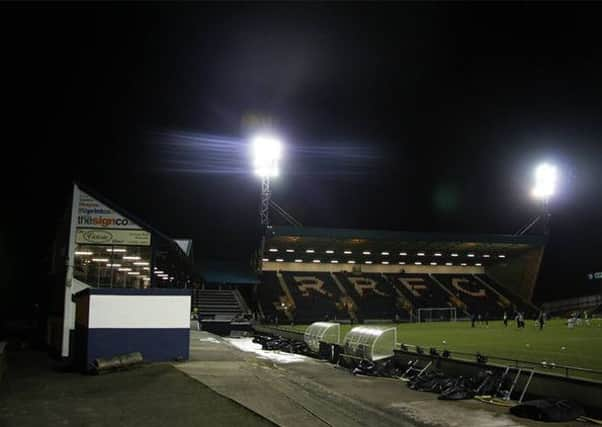Blog: Stark reminder of Raith’s history


At Dens Park, the main stand is in essence an isosceles triangle, a feature which comes from the stadium’s former bowl-like shape (incidentally, this means that sitting at the half-way line in the main stand is the furthest you can be from the action). The journey around grounds in Scotland has brought many different and unique experiences. From the surreal and unusual prospect of watching an amateur team play their home matches in a 52,000 all-seater stadium, to the rejuvenation in spirits at Albion Rovers via their Scottish Cup run and “pay what you can” initiative at Cliftonhill.
Last week, I ventured to Kirkcaldy to watch Raith Rovers’ midweek match against Alloa Athletic in the Scottish Championship. Their ground, Stark’s Park, fits into the earlier description of Scottish football grounds. Wedged in between a street and the busy Edinburgh-Aberdeen rail line, Stark’s Park most endearing feature is its grandstand. The main stand, unlike nearly every other main stand I’ve visited at a football ground, is L-shaped, covering a third of the eastern part of the stadium. The removal of asbestos and a new roof aside, the stand is essentially the same as it was when completed in 1926. The brainchild of architect Archibald Leitch - the man behind iconic stadia such as Highbury, Goodison Park, Craven Cottage and Anfield - the stand is truly one of a kind.
Advertisement
Hide AdAdvertisement
Hide AdNormally, when Fraser (the photographer) and I visit a ground for a “Day at the Football”, we usually seek someone to chat to; to talk about their club, their allegiances and what they love about their team. At Stark’s Park, not only were there plenty of people to chat to, but a cracking story just fell right into our lap. Chatting to a man called Ian about the quaint nature of the main stand, he replies quite nonchalantly, “aye, they sold my Dad to pay for it”.
Now, this is not a sentence that is ushered from many lips. As it turns out, Ian’s father was Jackie Stewart, an outside-right who was sold to Birmingham City in 1948 and, essentially, proved to be the final payment for Leitch’s masterpiece. Stewart was City’s top scorer in his first season, and went on to play for a further six years, before returning to Kirkcaldy as a coach. Ian is part of the supporters committee – their honorary chairman is former Prime Minister Gordon Brown - who volunteer on match days to sell programmes, run the club shop and announce the teams. I can only assume the Rt Hon Mr Brown has not coordinated the half-time lottery draw yet this season.
The main stand, as is the rest of the stadium, is enigmatic of a club who have used profitable times in their history to update and maintain their ground. While Ian’s father move to England was the final instalment on the grandstand, its construction was financed by Alex James’ move to Preston North End in 1925. The modern stands behind each goal were erected in the mid-1990s, following Rovers’ incredible League Cup win over Celtic and the subsequent UEFA Cup run, which featured a trip to Germany to face the mighty Bayern Munich.
Stark’s Park is, as mentioned earlier, confined by its perimeters. There is a stand unused running along the western side of the park. The home fans, therefore, sit in the South Stand next to the Main Stand, while visiting supporters occupy the McDermid Stand behind the other goal, named after the father of the author Val McDermid who was a scout for the club. This makes the dynamic of the atmosphere at the game a touch odd. With the flanks empty, all noise comes from the South Stand, with the small contingent of travelling fans from Alloa struggling to create an impact being so sparse and so far away. It’s a shame that Stark’s Park cannot feasibly accommodate opposing fans closer to their own. Opposing supporters often feed off each other, the to and fro of the banter between fans being part of the matchday experience.
The other unusual aspect of Stark’s Park is that, with most of the 1000 or so punters behind one of the goals, Raith Rovers played substantially better in the second half when playing towards their own supporters, rather than with their backs to them. Alloa were leading at half-time thanks to a sweet strike from long range by Eddie Fearns. With strong vocal support, Rovers equalised 10 minutes after the interval thanks to a header from Dougie Hill. Despite a rather moribund first half from the home side, they arguably would have won had it not been for a fine performance from Alloa goalkeeper Scott Bain, donning a short-sleeved goalkeeping jersey akin to Gigi Buffon and disregarding the fact that he was playing on a cold, February Tuesday night in Fife.
A goal and a point apiece was the final outcome, neither ideal nor disastrous for either team. Still, the next couple of months will certainly be fascinating for Raith Rovers. The TV cameras travel to Kirkcaldy on Saturday for their Scottish Cup quarter-final with St Johnstone, and will follow them to Easter Road for their Ramsdens Cup final encounter with Rangers next month. Along with the newly-created play-offs in the Scottish Championship, we could well be seeing more of Raith Rovers, and one of Archibald Leitch’s finest creations, in the future.